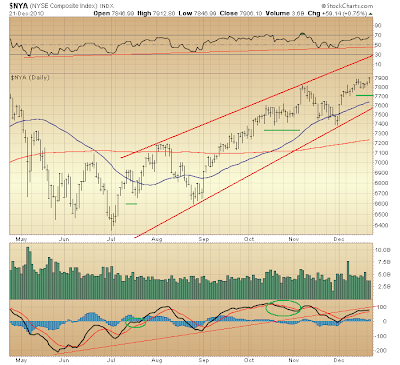Here is an interesting dissection of technical conditions developing as a presumed rising wedge forms off late-June bottom...

First, despite atypical relative strength (top panel) and momentum (bottom panel) behavior coinciding with November's formation of this prospective rising wedge's fourth wave (these technical measures typically weaken relative to their respective lows registered during the preceding second wave's formation, which here was during August) we see that, the NYSE Composite Index's momentum in November, indeed, broke its multi-month uptrend, and presently remains stalled below this trend line despite the market's persistent buoyancy over the past couple weeks. This evidence of growing weakness occurring some months into the market's post-flash-crash advance only is furthered by the NYSE Composite's recent momentum divergences, first at November top and once again right now. Thus, technical substantiation of a five wave advance nearing its end is seen accumulating, then.
Now, there is an interesting phenomenon seen developing during formation of the first, third, and now fifth waves of this presumed rising wedge forming off late-June bottom. This specifically is evidenced by price action and coincident momentum during formation of the "b" wave of each of this rising wedge's three impulse waves.
A little background...
What makes a rising wedge "special" in the framework of the Elliott Wave Principle is the fact that its impulse waves (i.e. waves 1, 3, and 5) subdivide into three waves rather than the typical five waves. So, waves 1, 3, and 5 of the rising wedge forming off late-June bottom subdivide into a-b-c waves, rather than fives waves, as is typical.
Observe how during formation of the rising wedge's first wave, its "b" wave (unfolding during the second week of July) saw the NYSE Composite index hit fairly hard, yet momentum held steady. Contrarily, during formation of the third wave's "b" wave (unfolding during the latter half of October) the NYSE Composite more or less traded sideways while its momentum decidedly fell.
Here we are, then, probably in the midst of forming the "b" wave of the rising wedge's fifth wave. Might we see an upwardly biased wave form develop in this instance and unfold in such a narrow range as causes the NYSE Composite index's momentum to fall more precipitously than occurred during formation of wave b of 3 in October? Certainly, this week and next increasingly promise to be as dull as Ben Bernanke, so the prospect appears reasonably good.
Thus might further weakening technical underpinnings usher in 2011 with prospect for a strong start to the new year lasting all of a day or three (completing wave c of 5, and coinciding with all manner of further technical divergences), only to be followed by an awful throttling the likes of which so very few presently fear.
There certainly is no shortage of technical weakness currently belying the market's seeming strength. Supposing this underlying weakness could persist for a couple weeks more and, indeed, deepen is no dilemma at this point. That the endgame appears at hand — resumption of the corrective wave that began in October 2007 — is a probability all the more furthered by the increase in chatter we are hearing in conjunction with major indexes (like the S&P 500) reaching levels last seen when Lehman Brothers declared bankruptcy (9/15/08). With so many technical problems weighing on a market pressing up against an area of resistance whose significance has been long-anticipated here, there is considerable reason to fear some shock obliterating today's well-entrenched complacency among a crowd whose firms likely will not survive the next phase of financial crisis whose chaotic, landscape-altering probability is nearly as certain as death and taxes...

* * * * *
© The Risk Averse Alert — Advocating a patient, disciplined approach to stock market investing. Overriding objective is limiting financial risk. Minimizing investment capital loss is a priority.
Analysis centers on the stock market's path of least resistance. Long-term, this drives a simple strategy for safely investing a 401(k) for maximum profit. Intermediate-term, investing with stock index tracking-ETFs (both their long and short varieties) is advanced. Short-term, stock index options occasionally offer extraordinary profit opportunities when the stock market is moving along its projected path.
Nothing is set in stone. Nor is the stock market's path of least resistance always known. More often than not, there are no stock index option positions recommended.
 There's an easy way to boost your investment discipline...
There's an easy way to boost your investment discipline...Get Real-Time Trade Notification!



















